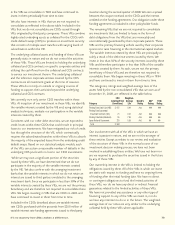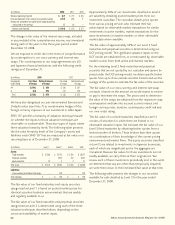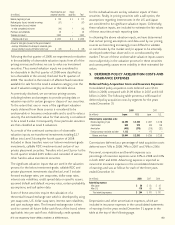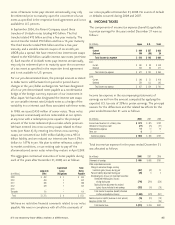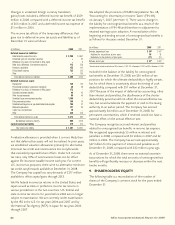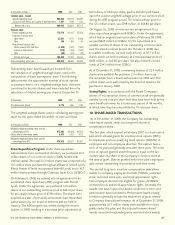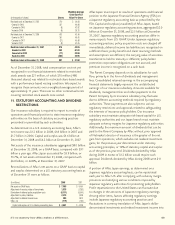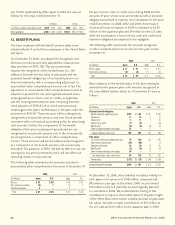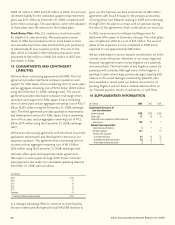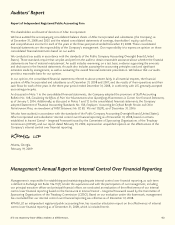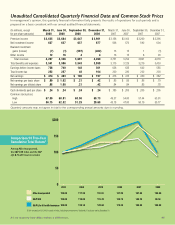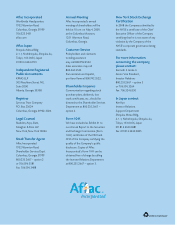Aflac 2008 Annual Report Download - page 93
Download and view the complete annual report
Please find page 93 of the 2008 Aflac annual report below. You can navigate through the pages in the report by either clicking on the pages listed below, or by using the keyword search tool below to find specific information within the annual report.
89
It’s no mystery how Aflac makes a difference.
Weighted-Average
Grant-Date Fair
(In thousands of shares) Shares Value Per Share
Restricted stock at December 31, 2005 270 $ 39.58
Granted in 2006 357 46.96
Canceled in 2006 (8) 42.92
Vested in 2006 (6) 38.75
Restricted stock at December 31, 2006 613 43.84
Granted in 2007 391 48.43
Canceled in 2007 (21) 45.88
Vested in 2007 (9) 42.06
Restricted stock at December 31, 2007 974 45.65
Granted in 2008 302 61.00
Canceled in 2008 (17) 52.86
Vested in 2008 (262) 39.95
Restricted stock at December 31, 2008 997 $ 51.68
As of December 31, 2008, total compensation cost not yet
recognized in our financial statements related to restricted
stock awards was $21 million, of which $10 million (480
thousand shares) was related to restricted-share-based awards
with a performance-based vesting condition. We expect to
recognize these amounts over a weighted-average period of
approximately 1.1 years. There are no other contractual terms
covering restricted stock awards once vested.
11. STATUTORY ACCOUNTING AND DIVIDEND
RESTRICTIONS
Our insurance subsidiary is required to report its results of
operations and financial position to state insurance regulatory
authorities on the basis of statutory accounting practices
prescribed or permitted by such authorities.
As determined on a U.S. statutory accounting basis, Aflac’s
net income was $1.2 billion in 2008, $1.8 billion in 2007 and
$1.7 billion in 2006. Capital and surplus was $4.6 billion at
December 31, 2008 and $4.2 billion at December 31, 2007.
Net assets of the insurance subsidiaries aggregated $8.0 billion
at December 31, 2008, on a GAAP basis, compared with $9.1
billion a year ago. Aflac Japan accounted for $5.9 billion, or
73.7%, of net assets at December 31, 2008, compared with
$6.0 billion, or 66.8%, at December 31, 2007.
Reconciliations of Aflac’s net assets on a GAAP basis to capital
and surplus determined on a U.S. statutory accounting basis as
of December 31 were as follows:
(In millions) 2008 2007
Net assets on GAAP basis $ 7,985 $ 9,050
Adjustment of carrying values of investments 1,835 (1,283)
Elimination of deferred policy acquisition costs (8,111) (6,540)
Adjustment to policy liabilities 2,474 1,928
Adjustment to deferred income taxes 593 1,813
Other, net (175) (760)
Capital and surplus on U.S. statutory accounting basis $ 4,601 $ 4,208
Aflac Japan must report its results of operations and financial
position to the Japanese Financial Services Agency (FSA) on
a Japanese regulatory accounting basis as prescribed by the
FSA. Capital and surplus (unaudited) of Aflac Japan, based
on Japanese regulatory accounting practices, aggregated $2.0
billion at December 31, 2008, and $2.5 billion at December
31, 2007. Japanese regulatory accounting practices differ in
many respects from U.S. GAAP. Under Japanese regulatory
accounting practices, policy acquisition costs are charged off
immediately; deferred income tax liabilities are recognized on
a different basis; policy benefit and claim reserving methods
and assumptions are different; the carrying value of securities
transferred to held to maturity is different; policyholder
protection corporation obligations are not accrued; and
premium income is recognized on a cash basis.
The Parent Company depends on its subsidiaries for cash
flow, primarily in the form of dividends and management
fees. Consolidated retained earnings in the accompanying
financial statements largely represent the undistributed
earnings of our insurance subsidiary. Amounts available for
dividends, management fees and other payments to the
Parent Company by its insurance subsidiary may fluctuate
due to different accounting methods required by regulatory
authorities. These payments are also subject to various
regulatory restrictions and approvals related to safeguarding
the interests of insurance policyholders. Our insurance
subsidiary must maintain adequate risk-based capital for U.S.
regulatory authorities and our Japan branch must maintain
adequate solvency margins for Japanese regulatory authorities.
Additionally, the maximum amount of dividends that can be
paid to the Parent Company by Aflac without prior approval
of Nebraska’s director of insurance is the greater of the net
gain from operations, which excludes net realized investment
gains, for the previous year determined under statutory
accounting principles, or 10% of statutory capital and surplus
as of the previous year-end. Dividends declared by Aflac
during 2009 in excess of $1.2 billion would require such
approval. Dividends declared by Aflac during 2008 were $1.1
billion.
A portion of Aflac Japan earnings, as determined on a
Japanese regulatory accounting basis, can be repatriated
each year to Aflac U.S. after complying with solvency margin
provisions and satisfying various conditions imposed by
Japanese regulatory authorities for protecting policyholders.
Profit repatriations to the United States can fluctuate due
to changes in the amounts of Japanese regulatory earnings.
Among other items, factors affecting regulatory earnings
include Japanese regulatory accounting practices and
fluctuations in currency translation of Aflac Japan’s dollar-
denominated investments and related investment income into


